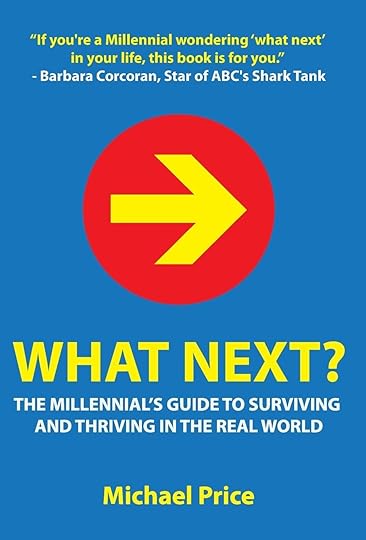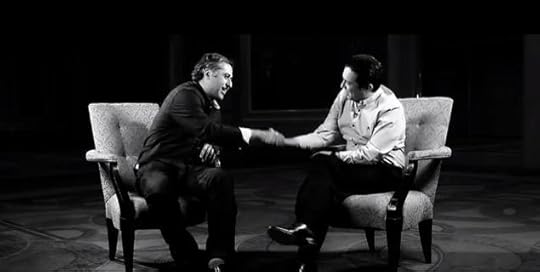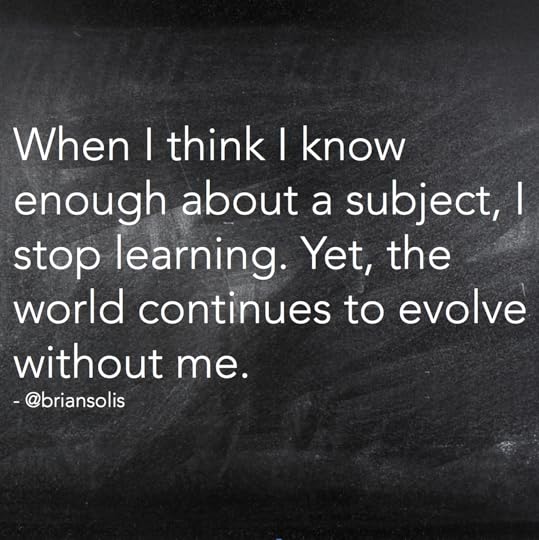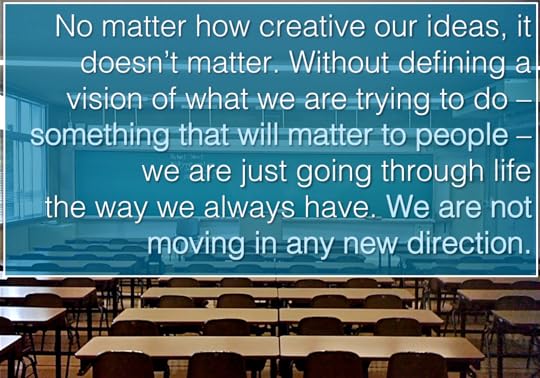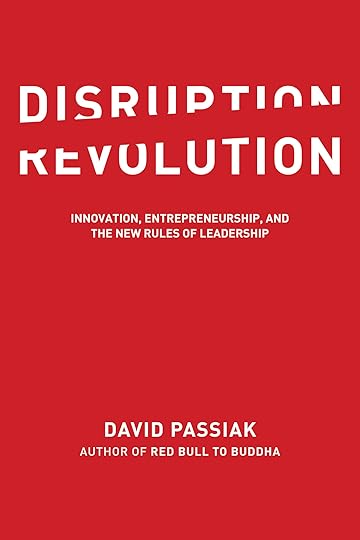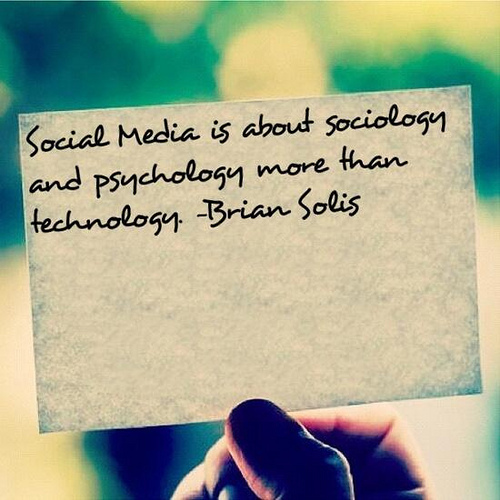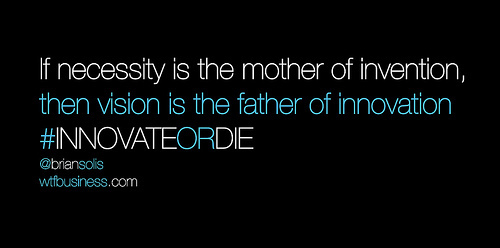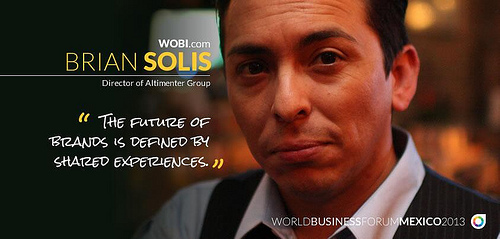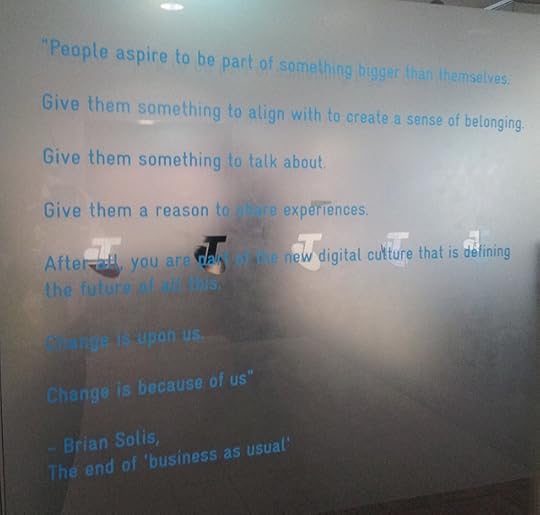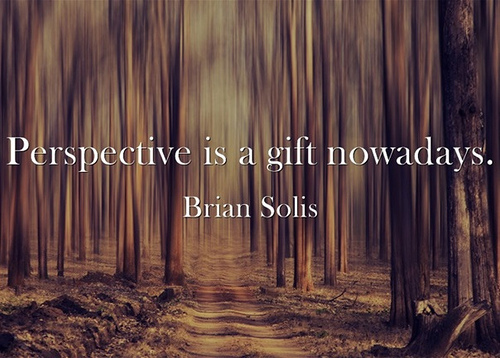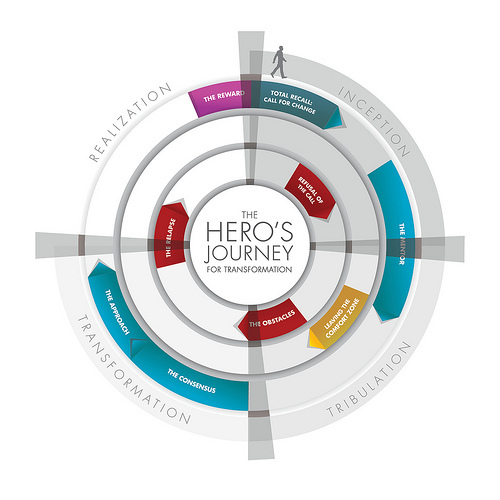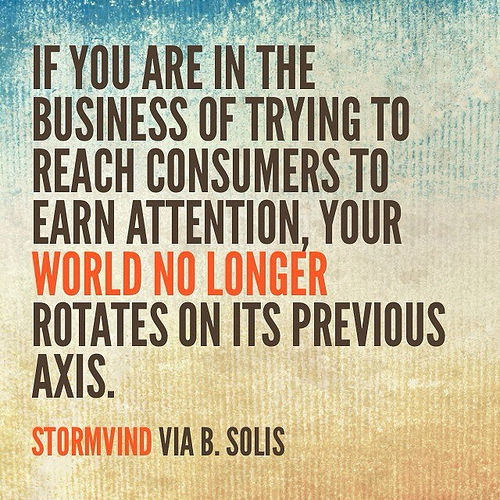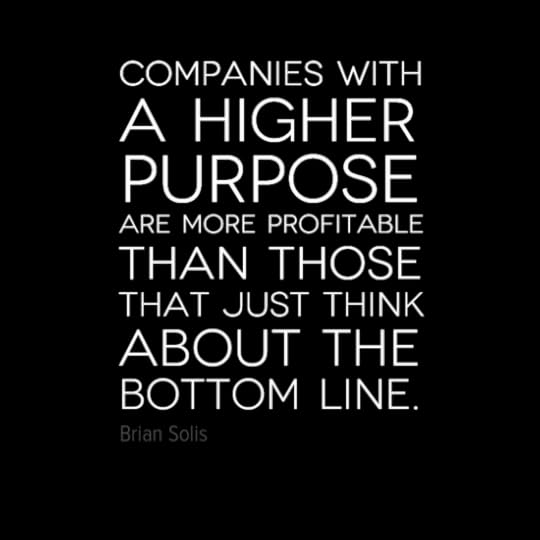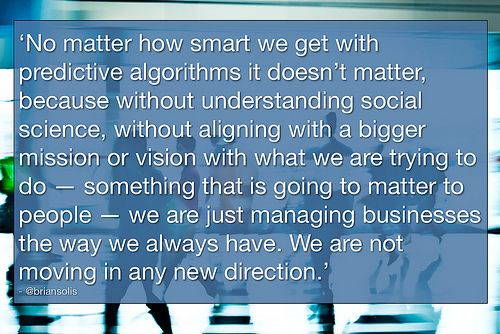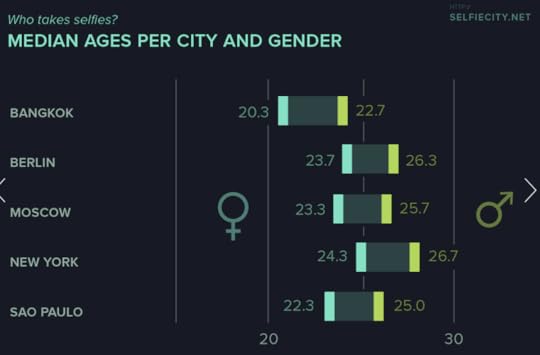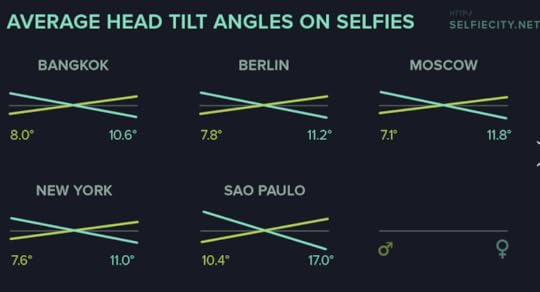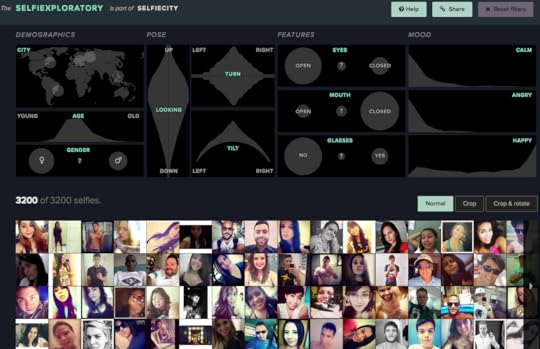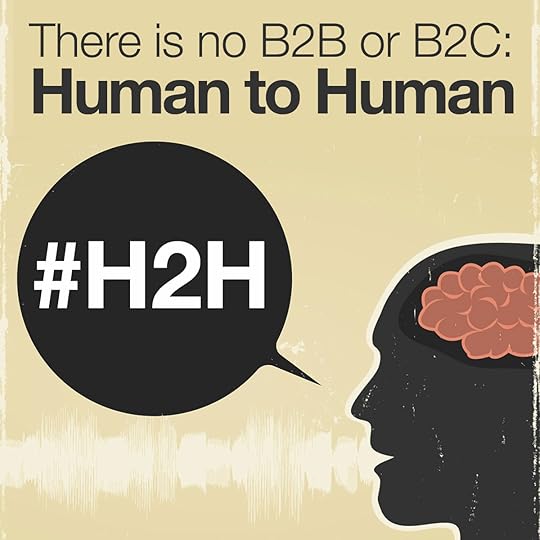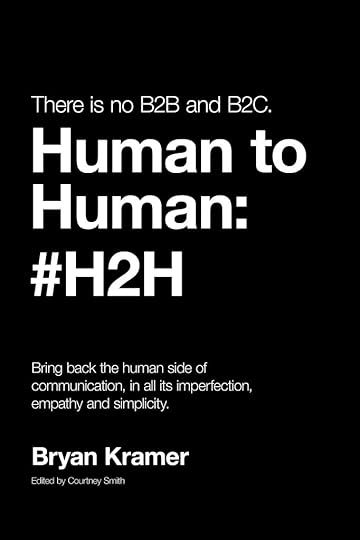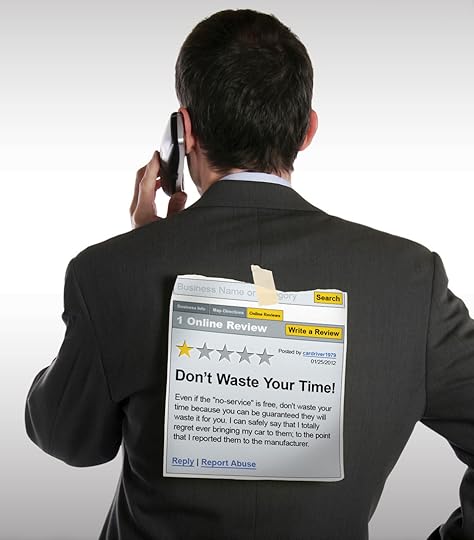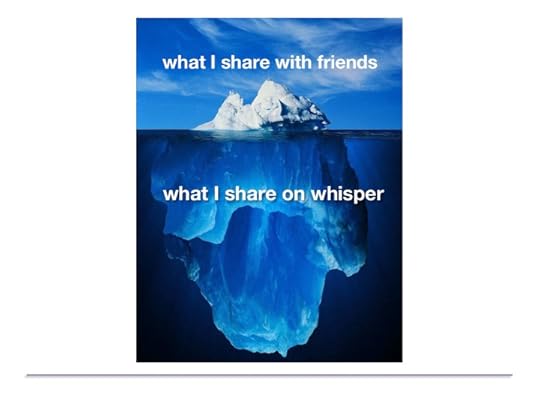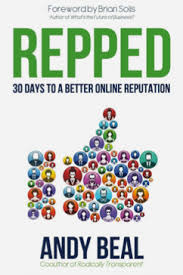Brian Solis's Blog, page 112
April 4, 2014
The Millennial’s Guide To Surviving Corporate America
Guest post by Michael Price (@michaelpriceles), millennial and author of “What Next? the Millennial’s Guide to Surviving and Thriving in the Real World”
A new generation has emerged and they now make up 36% of the U.S. workforce (source: U.S. Bureau of Labor and Statistics). Many have called them lazy, entitled, and unprepared to take on the challenges of the real world. They can often be seen walking into a hiring manager’s office with a gold star on their shirt, an empty resume’, and a shiny new MBA. Their mom may also be sitting in the lobby cheering them on and they may even come into an interview dressed in jeans, a hoodie and flip flops. In case you haven’t figured it out, the generation I’m referring to is The Millennials. You can discount them or you can hold them in high esteem, but one thing you can’t do is deny that they are here and they’re taking over. Accepting this reality has been a challenge for both Millennials entering the workforce as well as their Baby Boomer counter-parts looking to hire them.
Both Millennials and Baby Boomers are uneasy about working with each other, confused and concerned about what to expect. But none of that matters because despite the preconceived notions that both of these demographic groups have about one another, they must now work side by side. So it’s time to get on board and work together.
For Millennials who are frustrated about the conservative corporate environment, they must first understand the generation gap. Elder generations came up during a time when computers, smart phones and tablets didn’t exist. They didn’t have technology to allow them to do their jobs easier, faster, or more efficient. They also didn’t have the luxury of working remotely. For them, if they didn’t “punch in” precisely at 8:00 A.M. Mr. Boss was waiting around the corner to tap their shoulder and wave his finger in disapproval.
What Baby Boomers bring to the table is raw work ethic. They’re not afraid to get their hands dirty, roll up their sleeves and get to work. Despite the grumblings you may hear at the water cooler, Millennial’s are no different. In fact, Millennial’s are often times more likely to put in the hours than their elder counter-parts who may place more emphasis on a work-life balance. Millennials were born into a world where they’re “always on” and Corporate America loves this because Millennials embrace connectively after hours, as remote working privileges and company-issued smart phones allow constant access to the office 24/7. This may not be great for work-life balance, but in terms of molding an employee you can always count on, Millennials have you covered.
So how can Baby Boomers and Millennials work together effectively?
It comes down to mutual respect.
As outlined previously, there’s a generation gap that both the new school and old school must understand and adapt to. Finding this balance and creating an environment that everyone can appreciate largely rests on the shoulders of Baby Boomers. As long as Baby Boomers remain supreme as the managers and executives of businesses, they must create and re-define the environment and attitudes of their elder employees to embrace the new generation, take them under their wing and be willing to not just have Millennials work for them, but work with them. The generation gap between Baby Boomers and Millennials is unprecedented. Never before have we witnessed such a different perspective of employment from two different generations working alongside each other. It is vital that Corporate America understand this because the companies who refuse to re-define their culture to equally suit Millennials as they do Baby Boomers will turn down and lose incredibly talented people to competing firms that will embrace them.
If Corporate America doesn’t get their act together, Millennial’s will flee from employment in exchange for entrepreneurship. It’s happening all across the world and should we be surprised? Millennials were born into the era of eCommerce where anyone with $100 or less can throw up a website and monetize their passion.
So what are Millennials to do?
I’ve assembled four tips to help Millennials stop struggling and start thriving in Corporate America.
Let’s get to work…
1.) Know Your Role
No matter where you are in life, no matter how old you are, and no matter how much power or status you have, you will always have someone else above you or lateral to you that has the power to check and balance you. “Knowing your role” isn’t about being walked on and stepped over. It’s about being humble enough to realize that everybody above you once stood in your shoes, and as you climb the ladder, you too will one day gain power, respect, and admiration.
2.) Be Valuable
How can you add value to your position and to your company? This is a question you must ask yourself regularly. Adding value will allow you to rise as an asset. The first thing you can do to immediately begin providing more value is to figure out what you can do to make your manager and coworkers jobs easier. On the job, everybody’s overworked and underpaid and nothing brightens someone’s day more than having their load lightened. So offer up yourself to do some heavy lifting to lessen the load for others on your team. Striving to be more and more valuable is the best and easiest way to gain job security. The essence of being valuable is simply making yourself indispensable. Become so valuable that your manager just simply can’t live without you, and watch as raises, advancements, and lack of termination come your way.
3.) Be a Winner. Not a Whiner:
No one likes a whiner. They’re annoying, loud, and they are perceived as being weak individuals. Millennials love to whine because they’re used to getting their way and most of the time they’re used to getting things they didn’t earn. Don’t bring that mentality into Corporate America. Check that attitude at the door. Turn that frown upside down and transform yourself from a whiner into a winner. If something is bothering you, learn to separate real problems from exaggerated problems and ask yourself if you really have a bad job or are you just having a bad day. Odds are you’re just having a bad day. You may not have gotten the promotion or the credit you deserve, but just remember, you are new in your career and you are the low man on the totem pole. Your advancements, promotions, raises, and credit will come in due time.
4.) Know the Difference Between a Job and a Career:
In life, you will learn that there’s a time for everything. This is especially true when it comes to establishing and understanding the difference between a job and a career. Many jobs are undesirable. The hours may not be very flexible and management may not be very fair, but if you’re gaining valuable experience you win in the end. Nothing in life is permanent, so realize that some jobs may be temporary placeholders that you may be forced to endure in order to gain experience, build your portfolio, and move on to bigger and better opportunities.
So what is a Millennial to do when they just can’t seem to land a job that provides them with the environment that’s best suited for their attributes?
Michael Price shares his insight: “If you’re unhappy or dissatisfied with your job it’s important that you do an internal audit. Evaluate yourself and really be honest with the job/career you have chosen. Does it align with your aptitude, your lifestyle, and your values? If your answer to these questions leads you to seek employment elsewhere, you must first set-aside conventional wisdom in terms of your approach to the job seeking process. If you truly want the job of your dreams you must widen your scope of opportunity across the entire country. Be willing to take a job wherever one is available, even if that means you have to move. You must also look at the entire job hunting process differently. Using online job posting sites are great tools, but they are just tools, not the entire toolbox. If jobs aren’t coming to you by way of email via a job posting site, go to them directly. Start by researching every company in your industry across the country. Determine their average salary and employee satisfaction using tools like Glassdoor.com and then contact every single companies HR department on your list. Someone will be bound to hire you, but it requires that you put in the work.”
As Baby Boomers move closer towards retirement and Millennials take the reins of the workforce a transition must take place. The success of this hand-off relies upon the actions and attitudes of work performed today. This isn’t just about Corporate America. This is about the future of American prosperity, because in order for America to continue to lead the world in innovation we must build and re-build our workforce to better align with one another. We’ve got a lot of work to do, but it can be done.
Remember that age-old acronym T.E.A.M? Together Everyone Achieves More. That couldn’t be any further from the truth.
Photo credit: Shutterstock
March 28, 2014
How a Conversation About a New Movie Made Me Rethink How I Chase My Aspirations
On this episode of Revolution, I invited, or rather subjected myself to the antics of my good friend Hooman while on camera. In San Francisco, he’s best known as one of the main personalities on the drive-time morning show at Alice 97.3. In Silicon Valley, he’s an active participant in learning and shaping how technology affects consumer entertainment.
Now he’s in the movie business…or at least trying to break in. But how and why does he think he can make it in such a tough business. He had an interesting idea…
In 2010, there were 968 films released in theaters. As a budding film producer, Hooman saw mobile as a way to help bring to life a different kind of movie. Wearing many hats as the co-writer, director and producer of Olive, he was able to shoot the first full-length feature film shot entirely on a smartphone.
Inspired by The Triplets of Belleville and Amélie, Olive is the story of a little girl who transforms the life of three people without speaking a word. The film stars four-time Emmy and two-time Golden Globe winner Gena Rowlands and features five original songs by Dolly Parton. The film is currently awaiting distribution and that’s when the conversation switched gears.
In the middle of our discussion about his film and the story behind it, we veered into a different, but complementary conversation about the importance of being an active and productive member of communities that are personally and professionally important…in the real world as well as online.
I found this particularly relevant.
Over the years, I’ve found myself going to less and less events, meetings, and meetups. Sometimes I feel like I’ve been coasting along lately.
See, during the rise of Web 2.0, I was everywhere. I invested time, resources, and money in building out the startup scenes in Seattle, New York, Los Angeles, Austin, and San Francisco. Now I use the excuse more often than not, the same excuse I hear from everyone else, “I’m just too busy.”
With the books, speaking, research and my work at Altimeter Group, I’m always traveling or heads down it seems. When home, I try to catch up on emails, calls and meetings. But, I also unplug. As Bob Russell wrote for Duke Ellington, outside of my everyday work, I just “don’t get around much anymore.”
I’m learning that finding the balance isn’t an endgame but instead an ongoing journey. This current leg of my journey though is creating a routine that’s becoming a comfort zone. The path to achievement may require norms, however I’ve learned that breaking away from routine and stepping out of comfort zones is how we learn and discover new horizons.
Everyone is busy. It’s what you do with your time that defines not just the moment but the course of what you do next and also the actions of the people around you. It’s how you move forward.
As Hooman says, “Get out there!”
He humbly shares that it’s easy to sit at home. But to get anywhere, to bring your goals to life, you must make an effort. You must engage. Help where you can. And, as he believes, “don’t expect anything in return.”
It’s that last piece of advice that reminds me of the power of reciprocity. For Hooman, this is a personal experience and part of the challenge he’s learning to accept. Not everyone thinks this way though. Give and you shall receive. Do so to expect something in return and you shall realize distance between you and the communities you value. He also cautions us to “not be a sucker either. People will try to take advantage of your connections to propel themselves ahead of you. Help because you want to. But don’t forget the role you play in where you are and where you’re going.
You can’t do it alone…
Invest in relationships. Appreciate people who bring value to you and your network. At the same time, ensure you’re surrounded by people who also appreciate you. It’s how you’ll get to where you’re going whether solo or with a little help from your friends.
1) Embrace technology to lead it rather than react to it.
2) Build meaningful relationships, don’t just network to work your way upward.
3) Become part of the community, invest in it and don’t just take from it.
4) Give freely because you want to…because it’s where you can add value.
5) Earn what you deserve.
Please take a moment to watch what I hope is a refreshing discussion…
Watch the Oliver trailer…
Take a look at how Hooman and team made Olive using smartphones…
Subscribe to BrianSolisTV here.
Connect with me: Twitter | LinkedIn | Facebook | Google+ |Youtube | Instagram
March 21, 2014
The Future of Learning is Stuck in the Past: Why education is less about technology and more about behavior
Here’s a story I haven’t shared much, but I’m doing so now because of an opportunity I recently had to present at the Learning Technology conference in London. Over the last two years, I’ve personally studied learning technology and also learning behaviors to relearn how to engage Generation C through analog and digital media.
While writing WTF, I studied the learning patterns and preferences among Generation C and how they differed from less connected students. What I learned reshaped how I assemble and present material, how I write, and how I visually communicate. Furthermore, it inspired me to restyle the UI, design and layout, and the flow to function and look less like a traditional printed book and instead perform with the familiarity of a digital medium in an analog package. For those who have read the book, this explains the square shape and four-color format as it mimics a screen. This work also represents why there’s a navigation bar throughout the book and graphical breaks that are presented with cadence.
In the end, this experience made me rethink everything. If I could take these learnings into a book, could it apply to conventional text books? Could it encourage a new way to teach rather than force students to conform to customary methods? What was clear though is that technology plays a part in all of this but the real story was influenced by behavior…behavior that’s different than the world I know. As tempted as I was to apply these resources to building a killer digital app for the book, it was a lesson to re-examine everything we take for granted today, everything we do simply because it’s the way things have always been done, and more importantly, a lesson in restraint. By restraint, I mean holding back from using technology for the sake of technology and instead take a few steps back to take something ordinary and make it matter in a digital society.
As a result of this work, I was invited to present at Learning Technologies in London to share my experience and outlook on the future of education and training. Ahead of the event, I spent some time discussing my presentation with Jon Kennard of Training Zone. I wanted to share that conversation here…
Why go all the way to London to talk about the future of learning?
Learning Technologies is one of the most prominent events where the discussion of technology versus behavior needs to gain momentum. I was more than excited to share my research…I was also eager to learn from other experts from around the world.
A, B, C, Easy as Can’t Teach Me
I see Learning Technologies as an opportunity to share and learn from those defining the future of learning and those also confused, frustrated or intimidated by it. Technology, taking learning out of the discussion for the moment, is part of the solution but it’s also part of the problem. In my research, I explore the dynamics of human behavior from a bottom-up or escalation perspective. Whether you’re a student in university or an employee learning new skills or procedures at an organization, the philosophies and systems governing education are traditionally designed from that of a top-down approach. Yet how we use technology in our real life is completely different than how businesses or schools are using it to teach me. There’s an incredible disconnect and the gap is only getting wider.
Let me give you an example…
In the past, education was something designed by experts who assembled the knowledge sources and materials necessary to prepare students for the next related subject or perhaps for a particular profession or overall direction. As technology was introduced into our everyday culture, it did so usually from the top down, typically in work or school simply because of the high purchase and management costs. Here, technology was meant to increase efficiencies, reduce long-term costs, and improve the dynamics for learning. Organizations were initially responsible for how we were introduced to technology and therefore how we used it. This process largely governs how we learn today.
As cost and adoption barriers fell, technology worked its way into consumer homes. With the rise of social and mobile, technology is now part of our everyday lifestyle. The result however, is that consumer familiarity with technology and how quickly they adopt and incorporate it into all they do has outpaced that of companies and institutions. The impact is profound. People are learning, communicating and collaborating differently in their personal life. Yet elsewhere, they’re expected to follow dated protocol that is at best counter-intuitive. This is causing a revolt which is only going to become increasingly dire as time and technology progress.
Students, employees, are fueling an escalation of expectations and demands to do things differently. At the same time, decision-makers are struggling to figure out why investments don’t pan out according to plan. They still see how people use technology as novelty and even frustrating because it’s always compared to the way the world was and not the world as it’s changing. The only way to take a meaningful step forward is to understand how to adapt legacy investments, systems and processes to pave the way for a more engaging and productive future for all.
Right now, we take new technology and give it to an architect who already sees the world differently, the way it’s always been. Therefore they take something that’s native to a new world and forces it to comply within a legacy paradigm defined by dated philosophies, systems, and reward systems.
No matter how creative our ideas, it doesn’t matter. Without defining a vision of what we are trying to do – �something that will matter to people – �we are just going through life the way we always have. We are not moving in any new direction.
“What’s key to understand is how people are using technology and how their behaviors, values, and expectations have evolved. Once you do, you’ll see that technology becomes an enabler for something more natural”
Learning Starts with Unlearning
Said simply, the answer is not technology. Moreover, don’t force conformity because it’s the way you learned or because you’re forced to use legacy as a starting point. If you do, you will follow the ongoing march of complacency that throws technology at problems and each time with similar, lackluster or failing results. What’s key to understand is how people are using technology and how their behaviors, values, and expectations have evolved. Once you do, you’ll see that technology becomes an enabler for something more natural, creating a culture of learning and collaboration that’s more intuitive, organic, and successful. This gives rise to more than IT or technology experts. Digital anthropologists and other social and data scientists will help us empathize with a connected generation or Generation-C as I call them, to lead instead of react to each trend.
Everything starts with you. I understand it’s difficult and daunting. After all, there’s a reason why change is either slow or ignored. It takes courage to break what isn’t yet broken and rebuild it in a way that others can’t yet visualize, appreciate or support.
This is a time to rethink…everything. And, what a wonderful time it is to be alive for those who can see these challenges as opportunities to invent and reinvent all that makes the world go ’round.
Connect with me: Twitter | LinkedIn | Facebook | Google+ |Youtube | Instagram
Image credit: Shutterstock
March 19, 2014
The Future of Learning is Anchored by History: Why education is less about technology and more about behavior
Here’s a story I haven’t shared much, but I’m doing so now because of an opportunity I recently had to present at the Learning Technology conference in London. Over the last two years, I’ve personally studied learning technology and also learning behaviors to relearn how to engage Generation C through analog and digital media.
While writing WTF, I studied the learning patterns and preferences among Generation C and how they differed from less connected students. What I learned reshaped how I assemble and present material, how I write, and how I visually communicate. Furthermore, it inspired me to restyle the UI, design and layout, and the flow to function and look less like a traditional printed book and instead perform with the familiarity of a digital medium in an analog package. For those who have read the book, this explains the square shape and four-color format as it mimics a screen. This work also represents why there’s a navigation bar throughout the book and graphical breaks that are presented with cadence.
In the end, this experience made me rethink everything. If I could take these learnings into a book, could it apply to conventional text books? Could it encourage a new way to teach rather than force students to conform to customary methods? What was clear though is that technology plays a part in all of this but the real story was influenced by behavior…behavior that’s different than the world I know. As tempted as I was to apply these resources to building a killer digital app for the book, it was a lesson to re-examine everything we take for granted today, everything we do simply because it’s the way things have always been done, and more importantly, a lesson in restraint. By restraint, I mean holding back from using technology for the sake of technology and instead take a few steps back to take something ordinary and make it matter in a digital society.
As a result of this work, I was invited to present at Learning Technologies in London to share my experience and outlook on the future of education and training. Ahead of the event, I spent some time discussing my presentation with Jon Kennard of Training Zone. I wanted to share that conversation here…
Why go all the way to London to talk about the future of learning?
Learning Technologies is one of the most prominent events where the discussion of technology versus behavior needs to gain momentum. I was more than excited to share my research…I was also eager to learn from other experts from around the world.
A, B, C, Easy as Can’t Teach Me
I see Learning Technologies as an opportunity to share and learn from those defining the future of learning and those also confused, frustrated or intimidated by it. Technology, taking learning out of the discussion for the moment, is part of the solution but it’s also part of the problem. In my research, I explore the dynamics of human behavior from a bottom-up or escalation perspective. Whether you’re a student in university or an employee learning new skills or procedures at an organization, the philosophies and systems governing education are traditionally designed from that of a top-down approach. Yet how we use technology in our real life is completely different than how businesses or schools are using it to teach me. There’s an incredible disconnect and the gap is only getting wider.
Let me give you an example…
In the past, education was something designed by experts who assembled the knowledge sources and materials necessary to prepare students for the next related subject or perhaps for a particular profession or overall direction. As technology was introduced into our everyday culture, it did so usually from the top down, typically in work or school simply because of the high purchase and management costs. Here, technology was meant to increase efficiencies, reduce long-term costs, and improve the dynamics for learning. Organizations were initially responsible for how we were introduced to technology and therefore how we used it. This process largely governs how we learn today.
As cost and adoption barriers fell, technology worked its way into consumer homes. With the rise of social and mobile, technology is now part of our everyday lifestyle. The result however, is that consumer familiarity with technology and how quickly they adopt and incorporate it into all they do has outpaced that of companies and institutions. The impact is profound. People are learning, communicating and collaborating differently in their personal life. Yet elsewhere, they’re expected to follow dated protocol that is at best counter-intuitive. This is causing a revolt which is only going to become increasingly dire as time and technology progress.
Students, employees, are fueling an escalation of expectations and demands to do things differently. At the same time, decision-makers are struggling to figure out why investments don’t pan out according to plan. They still see how people use technology as novelty and even frustrating because it’s always compared to the way the world was and not the world as it’s changing. The only way to take a meaningful step forward is to understand how to adapt legacy investments, systems and processes to pave the way for a more engaging and productive future for all.
Right now, we take new technology and give it to an architect who already sees the world differently, the way it’s always been. Therefore they take something that’s native to a new world and forces it to comply within a legacy paradigm defined by dated philosophies, systems, and reward systems.
No matter how creative our ideas, it doesn’t matter. Without defining a vision of what we are trying to do – �something that will matter to people – �we are just going through life the way we always have. We are not moving in any new direction.
“What’s key to understand is how people are using technology and how their behaviors, values, and expectations have evolved. Once you do, you’ll see that technology becomes an enabler for something more natural”
Learning Starts with Unlearning
Said simply, the answer is not technology. Moreover, don’t force conformity because it’s the way you learned or because you’re forced to use legacy as a starting point. If you do, you will follow the ongoing march of complacency that throws technology at problems and each time with similar, lackluster or failing results. What’s key to understand is how people are using technology and how their behaviors, values, and expectations have evolved. Once you do, you’ll see that technology becomes an enabler for something more natural, creating a culture of learning and collaboration that’s more intuitive, organic, and successful. This gives rise to more than IT or technology experts. Digital anthropologists and other social and data scientists will help us empathize with a connected generation or Generation-C as I call them, to lead instead of react to each trend.
Everything starts with you. I understand it’s difficult and daunting. After all, there’s a reason why change is either slow or ignored. It takes courage to break what isn’t yet broken and rebuild it in a way that others can’t yet visualize, appreciate or support.
This is a time to rethink…everything. And, what a wonderful time it is to be alive for those who can see these challenges as opportunities to invent and reinvent all that makes the world go ’round.
Connect with me: Twitter | LinkedIn | Facebook | Google+ |Youtube | Instagram
Image credit: Shutterstock
March 4, 2014
Disrupt or Be Disrupted: Welcome To The Disruption Revolution
Sometime toward the end of last year, I spent some time with David Passiak (@Passiak), author of Red Bull to Buddha: Innovation and the Search for Wisdom. At the time, he was leading an ambitious project to connect over 20 innovators in the tech startup world and share their perspectives in one, free, book…Disruption Revolution: Innovation, entrepreneurship and the new rules of leadership.
The book takes a case study, thematic approach that moves beyond buzzwords and industry jargon [thank goodness] to highlight emerging trends and best practices that are contributing to the future of business, society and culture.
I joined a group of folks that I admire including, Chris Anderson, Sarah Lacy, Robert Scoble, Jeremiah Owyang, Seth Godin, Dr. Natalie Petouhoff, Steve Rubel, Frank Speiser, among others.
I asked David if I could share our conversation as a book excerpt here and he obliged.
Enjoy…
What’s the Future of Business (#WTF)
Brian Solis is the closest thing that the new media and technology startup industry has to a rock star [I don’t know about that…I can think of people who are really rock stars, but thank you] —relentlessly speaking, author of several bestselling books, producer of Pivot, one of the industry’s most innovative conferences, advisor to hundreds of companies and global brands, and principal analyst at Altimeter Group, a leading firm focused on disruptive innovation.
Highlights include:
• Why Experience Design is the next evolution of social
• The connected consumer and true digital convergence
• Why branding is more important now than ever before
• How constraint drives innovation, and why we should always be in perpetual startup mode
This entire interview focuses on the big picture. It starts with how social media disrupted business, and then moves to the next iteration of the social Web that Brian refers to as true digital convergence. Brian reminds us that there are always constraints on resources. True innovation requires creativity, vision, and empathy and is a way of life.
DP: I remember meeting you with a group of bloggers back in 2006 before social media was considered a formative field. You were one of the first people that I thought really “got it” in terms of understanding the revolutionary potential of these emerging communications platforms to change everything.
Was there an “a-ha” moment when you realized social media was going to be so big?
SOLIS: I’ve been working on this officially since 1997, when I created a new department within the marketing organization aimed at message boards, communities, and influencers. They were essentially the precedent of bloggers writing about trends, but using websites to create online magazines. I believed that this was the future of engagement, marketing, and services, and so I started a company in 1999 called FutureWorks dedicated to that practice i.e. the works of the future, sort of a lab but also an agency. I ran that company until 2011.
In those iterations, there were web 1.0, web 2.0 social media, etc. I always believed that the next thing was on the horizon, so I constantly reaffirmed my belief that it was OK to be in this perpetual startup mode. I always called that company a startup – whatever year we were in, it was a 7-year-old startup, a 10-year-old startup – because we were constantly experimenting and practicing new philosophies. We were adapting or inventing new business models along the way.
Even today, I still wouldn’t necessarily say that we are at that next big thing. Social media was one of those specs, those iterations—albeit, one of the bigger ones—but the next thing on the horizon is true digital convergence. That is what I’ve been focusing on with my last two books and my latest work with Altimeter Group.
DP: Do you think we’ll still use the term social media in 5 or 10 years or is it the new norm now that we are moving to this era of digital convergence that you are talking about in your past two books?
SOLIS: That’s a really good question. I used to be a staunch defender of the term because it was much more than a classification. To me it was a representation of a shift in philosophy. Meaning that you’re not just creating, pushing and distributing media; you are sort of facilitating and democratizing it. That comes with a tremendous shift in the culture.
Five years from now, I could see us still using the term social media, though not as a classification but as a movement. For example, social media is sort of delivering this Undercover Boss moment to a lot of organizations, if you will, by allowing people to better see and reflect on the activities that are taking place outside the C-suite. It also humanizes the organization from the inside out so that it forces people to have conversations that they might not have otherwise had. That would be the context in which I see it being used. But from a technology standpoint we would have been deeply ingrained in this shift from social to digital convergence.
DP: I know in recent years there’s been a lot of focus on disruption, particularly among entrepreneurs and investors. Do you think this has changed the way people approach creating startups? For example, is there more emphasis on a quick exit and repeatable patters vs. trying to think really big and build the next Google?
SOLIS: Well, it’s almost a trick question. Disruptive technology and disruption overall is an effect of meaningful innovation. It means that it is already disrupting something. Entrepreneurs say that they are disrupting something as a form of aspiration, which is to some extent desensitizing or diluting the term and its importance. There are people who are becoming the next AirBnB for dog kennels. And then there are people focusing on true innovation. We see this in some of the most traditional industries going into biotech and green. If you look at Elon Musk, he disrupts anything that he touches. So I think it’s also a matter of your vision of creativity.
The word means innovation and that’s the word I think we need to consider more than disruption. At some point innovation could shift into disruption, but with disruption—this goes back to early economic theory, for example, creative destruction—something comes along and completely upsets the business model that exists only to be disrupted again with the next innovation. So it is a matter of focus, it’s a matter of state of mind. If you set out to disrupt something then you better disrupt it, but if you are saying you are going to disrupt it or that you are working on a disruptive technology, then you are fooling yourself and the people that are investing or trusting in you.
DP: That makes a lot of sense. I know that you work with a lot of advertisers and global brands. With social media, consumers are essentially involved in co-creating brands. What is the value of a brand and how do you help to define it if you have limited control over its creation?
SOLIS: I don’t believe you have limited control. I believe you have more control than you ever had before. I just think it is a matter of understanding what the word control means in this situation. Before, commanding control was “I speak, you listen” but the joke I used to tell everybody was that social media didn’t invent conversations or opinions. They have always been around. It’s just that now they are concentrated, searchable and indexable.
This becomes the future of branding in the sense that it is not just that they are co-created, but that they are concerted into a searchable collective. What I mean by that is if I go to Google and punch in key words, then you can’t control that moment of truth of what comes back. So what happens in a world where I ask somebody their thoughts, whether it is in a network or an app or I just review community exchanges? That’s a world that has completely been ignored up until now, and it is a world that’s been here since the Internet began, going back to the bulletin board system.
My point is that positive conditioning reinforces the types of conversations and exchanges that you want to have. Otherwise, you are just reacting to technology and you are reacting to impressions and experiences. The future of co-creation starts with the owner of the brand, meaning that I am defining what this brand means in today’s economy and what it means for you tomorrow from an aspirational standpoint.
It means that I have to put in a concentrated effort to define what it could be not just from an image standpoint, but from an emotional standpoint—what are you going to feel and what are you going to share?—because the future of co-creation has to do with shared experiences, not your ability to publish a thought but the experience that you have and share. Technology becomes an enabler to facilitate the positive conditioning of the experience you want people to have. That is why I talk about the future of branding as experience architecture. You define and strengthen it in every way and in every place possible.
DP: In your latest book, you are championing a new movement that aligns user experience with innovation and leadership. How does providing experiences create real business value?
SOLIS: If you ask Apple what business they are in, they will tell you they are in the experience business. If you ask Colgate what business they are in they will tell you they are in the confidence business. If you ask Virgin what business they are in, they will tell you they are in the high roller jet set business.
It’s a matter of giving your customer something to align with, not something to transact with. You look at one of the brilliant aspects of the Apple Store and now the Tesla Store, it is not about products, right? It is about experience. The experience is sort of embodied in the product, but it is also embodied in interactions with the company. It’s a holistic thing. That is the value of experience.
You will pay a premium for an experience. Some studies show as high as 15% more for a similar product if you believe you are going to get a better experience with it. So the value becomes something bigger than just the widget. That changes the entire model for business—how you support and interact with customers, how you attract and keep them. And that to me is something a little bit more substantive, meaningful over time.
Think about the future of brands as a collective of shared experiences—there is this disconnect between what you think your brand is and the experience of your brand that people are sharing with one another. So your first step is to figure out how do you close that gap. Second is how do you meet it so you’re not reacting to it—essentially creating value through experience where UX [user-experience] almost becomes like a philosophy or a way of life, a way of business, not just a series of designs for products or screens.
DP: So experiences are essentially qualitative and yet without analysis there can’t be any really relevant insights. How do you use technology and data to optimize experiences and create feedback loops, and where does the human interaction element fit into that?
SOLIS: That’s what I talk about in terms of the human algorithm: it’s that intersection of data science and social science. I think one of the biggest ways to solve this is the balance of quant and qual, where you take the idea of a focus group—intentions, aspirations, etc.— and you solve them with data and a/b testing. The research starts with a hypothesis and then ends with a series of educated questions.
Even outside of this promise of what is possible, you don’t know what you don’t know and you don’t research what you can’t envision. This is why I think the future really comes down to digital anthropology. It’s just better understanding of behavior so that you can meet the needs and expectations of your target audiences before they actually show up as a data point, if that makes sense. That is where the human interaction element fits in, because otherwise you are trying to force people into a box.
DP: I really like this especially—I was a former scholar of religion and culture before I got into social media.
SOLIS: Wow!
DP: I used to study the disruptive impact of the 60s impact and civil rights movements, so I looked a lot at grassroots protest and their use of new and emerging media—things like pamphlets and magazines and how they tried to culture jam and get pictures syndicated throughout the world to facilitate real meaningful changes.
I’m curious, in your latest book you referenced Joseph Campbell’s concept of the hero’s journey. What does it mean to go on a journey together with your consumers and basically evolve as a company focused on great customer experiences?
SOLIS: That’s a great question. Being a scholar and having studied religion and culture, you and I both know that the hero’s journey has deep roots in alternative religious aspects. I didn’t want to tackle that in the book (laughter). Most people actually believe—and I found this fascinating—that the hero’s journey aligns with popular culture (Star Wars and The Matrix) more than with actual religion. Academia really understands its true roots and I thought I would take a gamble to see if I could introduce it in a way that leaders could take at face value rather than try to unravel it.
In that regard, there are two journeys in the book. The first is this idea of digital ethnography and in all fairness you can’t unravel this. The hero’s journey shows you that someone really smart aligned mythology in religion to these certain paths that these characters seem to follow. The point was that it took research and it took someone really smart to draw the lines and draw a map. And you can do the same thing for your customer journey today. You can understand where they’re going, what is the context of what they’re trying to do, and what happens in each one of those stages.
The idea was just to align the digital ethnography to paint your own hero’s journey for your customer. Then, I wanted to inspire you to go along the journey with him or her to reduce the friction and create an ecosystem that was really special to be around before, during and after the transaction.
The second reference is the idea that it is not just about the customer and the journey you need to help and transform. It is also this idea the person within the organization who has to really think about its promise and opportunity is going to meet his or her own path of resistance. You too are going to have to be your own hero in the hero’s journey and that’s why I talk about the psychology of change at the end of the book. In sales, they sometimes refer to this type of person as an internal champion for the customer—the person that becomes the customer advocate within an organization.
You are going on this journey together—you and the customer—each with your own areas of resistance, so you need to know what you should expect to encounter so you can be empowered instead of delusional. You’re going to tackle something that is challenging but is also great, and what you’re about to take on is truly a hero’s journey: something that is bigger than you, something that’s bigger than the customer, because it is co-created. This is at the true heart of relationships and engagement, so you’re essentially changing business, the philosophy of business, in the process.
DP: We’ve heard the term Gen X and Gen Y. In your new book you give us the term Gen C or the connected consumer. So what is the connected consumer and how are they different from traditional consumers?
SOLIS: This is a big, big conversation. The easy answer is this—when we talk about Gen Y, Gen X and Gen Z, or Boomers and Millennials, we really tend to go down the demographic spiral. That limits our view of what is possible.
For example, you and I are both analog. We had to learn how to use digital in every iteration that has been thrown at us and they had to learn analog, which is crazy. And when you start to study behavior, you start to realize that older demographics, once they start using an iPad, a smartphone, or if they start getting a Facebook or Pinterest account, actually start to exhibit a lot of similar behaviors to Millennials. It’s fascinating. While it is not as extreme, there are similarities. This really introduces psychographics.
Talking about Gen C was my way of saying, “Stop looking at demographics and look at behavior.” Generation C is a collective of connected consumerism that just acts, thinks and influences differently than our traditional customer. It is a way to get people to see things differently, not by age but by their behavior.
DP: Without awareness there can be no consideration. How does advertising factor into the whole equation and how do you think advertising has evolved since everything has become so social?
SOLIS: Traditional advertising still works. Don’t get me wrong. There’s a reason why the Super Bowl is amazing in terms of what a good creative spot will actually do. The way I look at the difference between the Super Bowl and everyday advertising is that they’re actually trying to make it a shared experience. They want you to feel it; they want you to talk about it. That to me is the premise of how advertising can be more meaningful. It is not just a creative idea: it comes back to good old-fashioned storytelling, if you will.
The evolution of advertising takes the storytelling format and gets it into the stream in a way that’s much more meaningful. This is why you see native advertising starting to take off, things like social networks, and different blogs starting to plug in in-stream advertising in the form of posts or sponsored posts. But they are all rooted in this idea of a journey. So it’s a story, a clickable journey that makes it a little bit more meaningful. I can’t just send you to a website because that will ruin the opportunity to capitalize on curiosity or an emotional connection we might have. I think awareness is a big deal but it’s just different. It’s much more thoughtful. We are already starting to see this happen today.
DP: Is what we’re saying here related to how the importance of the brand is really, really critical right now?
SOLIS: Yes, it’s more important than ever before. For example, I have a relationship with MTV. You and I probably used to watch music videos and that was what MTV meant to us. And then somewhere in our young adult life, it started to become a TV channel—things like The Real World. It would be videos and then programming, but today MTV is something completely different to the Millennial and to Gen C.
If you look at the relationship they have with MTV and even the relationships they have with artists, it’s no longer the idea of an artist taking on a meaning where I’m going to put posters on my wall because that artist signifies who I am and the artist becomes the avatar for that person. Instead, it’s this notion that the artist becomes part of who you are. You have a direct connection and can have meaningful exchanges across social platforms, which are integrated into your own network of relationships. It’s almost like a piece of your DNA, not your total DNA.
So the idea of a brand has to have an emotional connection that people will feel like you are part of them. This is why customer studies show that things like values, vision, and human empathy are becoming much more important triggers in terms of a brand relationship rather than sexiness or typical paid endorsements, and this is why—going back to your original question about social media—I believe that social media is going to have the true impact because the idea of becoming social means that you are by default becoming human.
The brand is more important than ever before because it’s going to make you re-think what your vision is, what your mission statement is, what your promise is. And then how do you bring that to life in everything you do inside and outside the company.
DP: You’ve advised over a thousand startups. As we were talking before you have essentially treated your own work as an evolving ongoing startup looking at the next big thing. How do you think startup culture has changed? How do you implement essentially a startup culture within an organization?
SOLIS: Startups back in Web 1.0 were really different. Technology was really new, it was really trying to find an early sense of mass appeal and just even the idea of a technology startup would get a lot of really creative funding. You really didn’t have to do much to get the attention of the world. In fact, you didn’t even have to do much to monetize.
Today, there’s still a sense of that legacy where your idea is great because it is your idea but I think the best businesses, the best startups, the best entrepreneurs are realizing that there is a mission to what they are trying to do and trying to solve for. There is a sense of purpose behind the startup and this constant growth hacking. Trying to solve for a problem using traditional means to do so only means that you have traditional outcomes.
So, what if you had to solve for something in a new way? I think the reality would be that you would find a new way. That to me is the source of the most successful startups and the most successful entrepreneurs. They are not satisfied because they are trying to disrupt something. They are not satisfied because they have series A or B funding and a valuation of a billion dollars. They are relentless in their pursuit of actually having an impact and measuring its impact in terms of permeation into a market.
That, to me is the true meaning of startup entrepreneurialism and growth hacking—the relationship between cause and effect and that—believe it or not—even as hot as startup technology is and startups in general are, and how important entrepreneurialism is to the American economy or even just the economy in general, it is still a rare trait amongst entrepreneurs: that true desire and passion to build something so meaningful that you never lose that core fire in everything that you’re trying to do because it becomes the impetus for how you make decisions moving forward.
Hopefully that made sense, because that for me is the spirit of entrepreneurialism in startups that gets missed out on in the allure of money, the lifestyle and publicity.
DP: Related to this idea of constraint, how does constraint relate to innovation?
SOLIS: There are so many catalysts for innovation, but I believe that constraint is the greatest. It’s also the one I mostly align with. I have never had resources. Even today, I don’t have the richest resources that allow me to do all the things that I have to do. Even with my latest book and all that I’m trying to do in my professional and personal life I still have to find creative solutions to do it.
I’m constantly innovating. Innovation, to me, is a way of life and it is not something that I see in a lot of entrepreneurs that I talk to. They are trying to build all-star advisory boards, trying to get celebrities to invest so they can align with names. They are trying to really hustle but I don’t know that they’re trying to innovate as much as they are trying to push. Swimming upstream isn’t the same thing as innovating.
#DisruptorbeDisrupted
Book website:
Direct download link
The hard copy through Amazon
Connect with me: Twitter | LinkedIn | Facebook | Google+ |Youtube | Instagram

March 1, 2014
#Philoselfie: Science behind selfie-expression
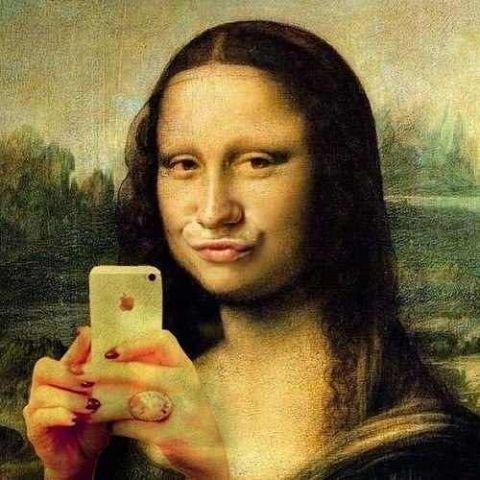
Oxford Dictionary’s word of the year is also one of the most fascinating movements in social is that of the selfie. Part vanity, part communication, part fun, and part absurdity, selfies represent a new generation of #selfieexpression cum egotistical emoticons…but not necessarily in a bad way. Nevertheless, the psychology and science behind selfies are strangely fascinating and therefore I continue to study and report on its evolution.
Selfiecity, a new research project, studies Instagram data from five cities around the world including Bangkok, Berlin, Moscow, New York, and Sao Paulo. Wired initially reported on Selfiecity’s initial findings. I didn’t want to be selfie’ish with the information so, I’m sharing the highlights with you here.
Right now, there are more than 79 million pictures on Instagram with the hashtag #selfie. You can add another 7 million for #selfies and 1 million for #selfienation. Not counted though, are the number of selfies that don’t include a meta reference beyond the visual that you are indeed looking at a selfie.
As you can see, selfies is a form of communication among the (early) twenty somethings.
Specifically in NY, more women (61.6%) share selfies than men (36.7%). But then again, there are historically more women active on social media than men as well. The average age for selfie-made women in NY is 23.3 whereas the age skews slightly higher for men at 26.7.
I know this is a burning issue for everyone concerned here. Selfiecity also tracked visual cues such as angle of head tilt. Women in Sao Paulo as you can see, were the most expressive with body position and tilt at 17-degrees compared to 10.6-degrees in Bangkok and 11-degrees in New York.
But wait, that’s not all Selfiecity is tracking. You can learn more about poses, the state of eye contact, how many people where glasses, and whether or not people open or close their eyes and mouth in selfies.
In summary:
#noglasses
and…
Eyes wide open…mouth wide shut.
I found this part particularly interesting. Selfiecity is also tracking the mood in each selfie. For the most part, people are happy, which hopefully conveys a positive sense of selfie-esteem or selfie-confidence 
In short, women are clearly smiling more than men. I guess that says something…
Additionally the team at Selfiecity learned…
On average, women tend to take more selfies than men. In Moscow, women account for 80% of the selfies. Yet, as people get older, this trend reverses. At or after age 40, men are more likely to take and post selfies than women.
At 150%, women are more likely to tilt their heads in photos over men.
According to Selfiecity’s mood analysis, people in Bangkok and Sao Paulo appear to be happier than people in Moscow. Perhaps it’s just that they’re more selfie-satisfied.
Please visit Selfiecity to explore the world of selfies for yourself.
#philoselfie
Connect with me: Twitter | LinkedIn | Facebook | Google+ |Youtube | Instagram

February 24, 2014
A Return to Simplicity, Empathy and Imperfection in Communication: Human to Human #H2H
Guest post by Bryan Kramer, author of the new ebook, “There is no B2B or B2C: Human to Human” and CEO of PureMatter
Marketing has become so complex, in segmenting audiences into “B2B” (business to business) and “B2C” (business to consumer). Being here in Silicon Valley, surrounded by titans of technology like Google, Facebook, Cisco, Twitter, LinkedIn and eBay to name a few, I’ve observed a downhill slope of complexity in marketing communication. This, plus the rise of social, digital and mobile channels, have created an atmosphere of anonymity, and the entire marketing ecosystem felt like a very cold, distant and impersonal place.
I fear that the social/digital/mobile world has created an angry mob of anonymous reactors who take short form communication literally. Until we learn to be mindful of what and how we share – what I call our “social body language” – and exercise our human empathy toward the mistakes and failures of strangers and the people we know, the online world of communication will remain somewhat of the “Wild West.”
That’s where “H2H” came from; we’ve been saying it in our agency, PureMatter, for over a decade. It’s also lived in many forms from many people, most popularly with P2P (person to person or people to people). Doc Searls (Cluetrain Manifesto + VRM), Chris Heuer, Christopher Carfi, Brian Solis and many others have been talking about how the dawn of a more social web, i.e. forums, discussion boards, and pre- Web 2.0 online communities, would eventually equalize the media landscape and give a voice and brand to customers while introducing the need for a human persona in business. As Brian says of P2P, “people are now brands and brands are now people.” And, most recently, Humanize by Jamie Notter and Maddie Grant, shared the benefits of people-focused businesses and how to lead the shift from inside out.
This evolution has been guiding our society back into one that requires a more personal approach. It is time for a reminder about our humanity.
Speaking Human
Consumers are confused. Why can’t we make it simple for people to understand what we’re selling, so they can more easily share their experiences and the value they felt with others? More importantly, why is it that what we’re marketing most often does not align to actual consumer experiences? I don’t care what language you speak, who your brand is or what message you’re trying to send, we all need to speak more human. Too often we complicate what we’re trying to say. Ironically, as our world becomes more customer-owned and socially enabled, we continue to see complicated, redundant, over-technical, and over-thought mass messages getting pushed out – and lost – in the ether. Is it really getting harder to stand out, with so much data and information out there… or is the answer just to clearly say what you mean, in understandable human words?
A Human Approach: Social Sensory Marketing
Humans are social creatures; this is something we all know and understand. I had the pleasure of interviewing Scott Hebner, VP of Social Business at IBM, and friend Kare Anderson, author, speaker, columnist and coach, about how human behavior fits into the context of social marketing. Given that humans consume socially, I wondered where social marketing is headed as it continues to mature. Both Scott and Kare explained in their own ways that the future of social marketing involves “human sensory building”, and how it will become necessary to intertwine this approach into the marketing experience at each stage of the customer lifecycle. When we are able to weave directly relatable human experiences into social situations, it changes how we share and consume information forever. Human Sensory Building means connecting marketing to our most basic human sensory system. The more you can map what you’re communicating to these senses, the deeper and more meaningful your connections will be.
Customers are Fickle Humans
Customers, as humans, are fickle and are so empowered today that they expect extraordinary, over-the-top experiences that rock their world. Nothing less will do. Gone are the days where feedback was kept quiet and experiences were collected around a review form. Today, your customer’s comments are transparent to your competitors, making it easier for them to publicly see your pain points. Comparisons are easier to make and product switching happens faster than ever. Customers are ready to move on unless they have one thing – an undying relationship with a person or people at your brand who made them feel uniquely special.
Becoming Better Storytellers
Between the convergence of social, mobile and digital technologies, the way we have learned as humans to communicate with each other has changed forever. Texting has enabled us to eliminate face to face, or at least mouth to ear, communications in short bursts. Character limits, like on Twitter, force us to be more succinct about the words we share with the public. Over 90% of human communication is conveyed through visual body language cues. So what happens, when technology leaves us with just under the remaining 10% of verbal non-visual communication, is a floodgate of communication without context. This is a huge problem that’s rewiring our human brains, in my opinion. Humans require context to understand concepts. Without boundaries, short bursts of communication, coupled with a faster-paced, noisy society and shorter attention spans is affecting how we, as humans, tell stories.
We need to become better storytellers. A commonality between humans is our emotions; we can’t help crying when others cry, laughing when others laugh. You can’t expect anyone to connect with your content, message, brand, values, if you don’t yourself. It’s that simple. Storytelling is a great way to communicate how you feel, or how you want your audience to feel. A story helps us understand how things fit into our individual experiences and gives us context to make decisions. Stories add the color, personality and relevance about what you’re trying to sell.
Technology and unsexy products will never go away and need to be sold, but shiny pieces of metal on their own will never be as interesting as the human interpretation of why they exist. 52% of consumers stop following a business’ page because the content is boring and repetitive (source: SMI). So make your marketing interesting. Create a mood through imagery. Speak at your audience’s level. Be smart and clever when you can. Tell me, don’t sell me.
These topics and many more are discussed and explored in Bryan’s recently released book: Human to Human #H2H, available on iTunes and Amazon

February 18, 2014
Hello, It’s Nice to Meet you…Again: Your Digital Reputation Precedes You
My good friend Andy Beal just released his latest book, Repped, 30 Days to a Better Online Reputation. Late last year, he asked me to write the foreword for the book and when I heard what it was about, I was all in.
Whether you realize it or not—or even wish to admit it—you already have an online reputation to protect. It doesn’t matter if you’re fresh out of college and hoping your past Facebook indiscretions don’t torpedo your career prospects, or a Fortune 500 company trying to make a name for itself in a crowded market, your reputation online is vital to your success. With dozens of examples and actionable tips, Repped demonstrates how a better online reputation can lead to improved job prospects, happier customers, fewer detractors, and most importantly of all, greater income. Repped is for individuals, professionals, small businesses, non-profits, and large corporations. Repped is for anyone that realizes the value of building a better online reputation.
As in every foreword I write, part of the deal is that I’m allowed to share the entire, unabridged version with you here (updated with a bit of tech news). Hope you like it!
Your Digital Reputation Precedes You: Do something about it…
With the social web and proliferation of apps, smart phones and always on internet access, we are becoming a society of accidental narcissists. I don’t believe we set out to become self-obsessed and to be honest, it’s not all that bad. Today’s digital lifestyle made self-expression not only possible but also acceptable. Selfies! What once would have been frowned upon as anti-social and narcissistic is now a form of everyday self-expression. It’s the new emoticon in many ways.
Sharing our lives is easy and it’s rewarding as friends, family and followers react with Likes, shares, comments, et al. With each update we receive positive reinforcement and are heartened to share more. We now are at the center of our own universe and with each day that passes, we share more of our lives and encouragement pushes our behavior toward extroversion. The words privacy and publicity now take on entirely new meanings as we place on display the very thing our ancestors cherished as privileged. With each update, post, selfie, we share a bit of ourselves that in their own way contribute to a semblance of our digital persona. This though, works for and against us…
Online, just like in the real world, actions and words speak loudly. Unlike real life though, your digital footprints are there for anyone to find on Google, social networks, and in communities. These disparate pieces are then assembled by employers, schools, friends, lovers, enemies, and anyone and everyone who wish to learn something more about you. Whether pure, sinister or simply inquisitive, whatever the reason, today these pieces construct a semblance of you and whomever sifts through your online legacy is left to their own surmise. This is too important to leave to chance. Online is the new real world. This is your life.
Repped is something we should think about but rarely do. We should be more methodical about what we share and why. But online engagement is teaching us to think in the moment instead of anticipating how those moments collect and assemble into something we didn’t initially foresee. Andy Beal is on to something here. And, if we each think deeply about it, we are indeed the masters of our own digital fate by choosing what we share and how we reward those whom guide us online. At the same time, we are also the beast of our own burden by sharing whimsically.
As Andy defines, repped is the result of conscious contributions that are intentionally additive. By investing in positive reputation updates, whether for you or someone else, ratings rise. Relationships flourish. Trust build. Thus, we enhance and shape an individual’s online profile to a more deserving standing. Again, it’s intentional.
If we do nothing and continue to post along our merry way, we become the victim of chance and circumstance. What others see and assume, the impressions that form, the opinions that arise, and the decisions they make as a result, are defined for us if we do not first define and reinforce what we want them to be.
Think about it this way. When you look in the mirror, you see a reflection of who you are right now. What if you could transform that reflection each day into someone you hoped to see staring back at you. With repped, we become architects of our desired reflection. If heedful, this digital reflection will ultimately work for us rather than against us. It’s more than how we see ourselves of course. It’s the broad strokes we paint in addition to the fine detail that we dab to paint a portrait that helps us now and in the future.
What separates reality from aspiration are your actions and words. You earn what you deserve.
It is what we share and how we build relationships that communicate who we are, not only to those whom we know, but also those whom we wish to know as well as those who are seeking to know more about us. It takes work yes. But then again so does anything that matters in life. Where everything begins though is what’s important. Most jump into online engagement without taking what is quite honestly the most important first step…connecting the threads of who you are, your aspirations, and who it is you want others to see.
Take a moment to answer this question…Why do you use social networks?
Is it to communicate your life to friends and followers?
Is it a form of self-expression?
Do you cast your actions to the proverbial audience to enchant or entertain them?
Take heart in what it is that moves you and those who follow you. Consider what it is they see as opposed to what you do online. You’ll find a great divide between what you say and the intentions behind them and what someone else hears or sees and takes away from each moment. Such is true in life of course, but here nothing really vanishes. Again, everything either works for or against you.
What is it that you value and how could that change with a bit of self-reflection?
I refer to today’s value system in social engagement as the 5 Vs. With each update, we seem look for something in return and each represent a shifting balance between what we treasure and what we think we treasure. The purpose of this exercise though is to contemplate the meaning of worth and in turn put stock in what it is we value and what it is that others will value…in the short and long term.
The 5Vs
1) Vision (I learn something, I’m inspired);
2) Validation (I’m accepted or justified);
3) Vindication (I’m right, cleared);
4) Vulnerability (I’m open); and
5) Vanity (Not egotism, but accidental narcissism. I’m important),
To earn or bestow increments of repped require intent and diligence. Nothing though begins without describing what it is you want people to know and see and how that tracks toward your personal and professional goals. The 5Vs require careful balance. Sometimes its best if you audit your online behavior to see which of the 5Vs were out of balance in the past. Doing so helps align your future engagement.
Some teenagers are aware of the “drama” that arises when their posts or pictures are taken out of context. In fact, they’re smart about covering their tracks. In some ways this is a divergent strategy from repped, but its example teaches us a lesson about the importance of building online reputations over time.
Rather than intentionally construct a desired presence, they simply remove traces of their communication after initial sharing. Some “whitewall” their networks by deleting everything after immediate engagement. Others “super log off” by deactivating their accounts when they’re not online. This behavior is what inspired the rise of an ephemeral web, one that automatically vanishes after a fixed amount of time. There’s a reason Snapchat and other apps and networks like it are wildly popular.
Snapchat and the ephemeral web represent an interesting evolution in social media in that it helps people “share without care” or better manage their digital footprint. The ephemeral nature of “now you see it, now you don’t” lets users be themselves, or sometimes encourages deviant behavior, without worry of future leverage against them. This comes at a time when colleges and employers, and everyone for that matter, are reviewing social networks as qualifying criteria for consideration. With ephemerality, the challenge for you and me though is the very thing that makes it so special and that’s the temporary nature of the moment.
Among accidental narcissists however, attention, popularity, and reactions are also catalysts for open sharing. As a result, Snapchat is experimenting with a hybrid of ephemeral messaging that adds a touch of permanence, such as its Stories product. There’s a sense of narrative that tells a story the way a user defines. But they still vanish in the end.
The ephemeral web is just one of two factions of the social web evolving today. The other movement underway is that of the anonymous web thanks in part to apps cum social networks Whisper and Secret.
When I first heard of Whisper, my initial reaction was wow, that’s interesting and potentially addictive. When I then heard about Secret, I felt similarly but then added the words dangerous and finite to the list. Whisper and Secret are representatives of the anonymous social web, which is a branch of the overall private social movement. Similar to its sister movement around the ephemeral web, these apps are promoting a behavior of sharing without establishing a link between identify and legacy.
Secret is interesting in that it connects friends and friends of friends. This makes the content relevant while sparking curiosity and conversations behind the scenes, online and the real world. Because it’s someone you know or could know, it adds a layer of intrigue to the mix. By including social validation engagement such as likes and comments, users are conditioned to continually share provocative thoughts, observations, and also secrets. It’s a promising mix that will keep secret public for the foreseeable future. However, I see it as more as disruptive novelty than I do as a long term stand alone app. It’s the anonymous movement that will outlast many early players. But that’s not the point. It’s how behavior changes in how we engage and share and the levers of identity we pull to align, or chose not to, our brand with the updates we we find interesting.
The people who define the social web are fickle and suffer from extreme cases of shiny object syndrome. But, anonymity can be healthy. Productive conversations can emerge beyond the juvenile antics of immature or mean people.
As founder of 4chan moot once said in a piece standing up for anonymity, “It’s incredible what people can make when they’re able to fail publicly without fear, since not only will those failures not be attributed to them, but they’ll be washed away by a waterfall of new content.”
The psychological conditioning of users though is shaped by how communities inside and outside of the communities react. And Whisper’s approach is among the most promising for a long-term play. With Gawker vial traffic czar Neetzan Zimmerman joining Whisper, the anonymous network will morph into a hybrid gossip, confessional, and allegation media network. And with Zimmerman’s first piece making the rounds that claims actress Gwyneth Paltrow is cheating on her husband, Whisper is officially on its way to competing for media and consumer attention while paving the way for anonymous social networking and sharing.
By crowdsourcing interesting revelations and curating or editing them a la TMZ, BuzzFeed and Upworthy, we may see these networks around for the foreseeable future.
We now live three lives online and will continue to do so in future; one that disappears, one that is secret, and one that sculpts our legacy. This reminds me of a poignant observation once shared by novelist and philosopher Gabriel García Márquez, “Everyone has three lives: a public life, a private life, and a secret life.” With the likes of Facebook, SnapChat and Secret, the thoughts shared by Gabriel García Márquez is now a digital prophecy come to life.
Now’s the time to consider how you want to be repped. Now’s the time to consider the value of online engagement and come to terms with what you want to invest into and take out of your digital life and the digital lives of others.
Repped will help you earn digital significance. Equally, repped will help you bestow significance unto others. The value you assign to engagement affects what you place and take out of this so-called digital life. The value we take away must only be surpassed by what we invest. This is the foundation for your digital legacy.
Give repped.
Get repped.
Brian Solis (@briansolis), digital analyst, anthropologist and author of What’s the Future of Business (WTF)

February 11, 2014
GoldieBlox vs. the Beastie Boys – What Constitutes Fair Use?
Guest post by Monica Corton (@momusing), Executive Vice President, Creative Affairs & Licensing Next Decade Entertainment, Inc.
Now that the Beastie Boys have gone on the offensive for the unlicensed and unauthorized use of their song “Girls”, written by Adam Horovitz and Rick Rubin, as used in the Goldieblox viral video campaign to feature their girls toy line . . . let’s try to unpack what actually happened and why songwriters and music publishers firmly believe that this was not a fair use. There have been rumors that the case was settled, however, I have checked, and the case is moving forward. More importantly, what is not moving forward well is the relationship between the tech/digital world and the music business.
There is a lot of misunderstanding on both sides. It is not acceptable for the tech/digital world to use our music, wait to be sued and then deal with licensing. No other industry exhibits this bad behavior more than the tech/digital sector. At the same time, I do believe it has not been easy for the tech/digital world to figure out where they need to go and what they need to do to secure licenses based on their business models. I also believe there has been a lot of bad advice that has been given to start ups from representatives who do not understand the music licensing world, and then there is the issue with the major music companies being difficult to work with. It’s complex and it has to end. They need us and we need them for the health of both groups. The Goldieblox vs. Beastie Boys case was highly publicized and I believe can serve as a spark for a positive discussion on a way to move forward.
Copyright Act
The introduction to the fair use section of the Copyright Act states that “[T]he fair use of a copyrighted work * * * for purposes such as criticism, comment, news reporting, teaching (including multiple copies for classroom use), scholarship, or research, is not an infringement of copyright. In determining whether the use made of a work in any particular case is a fair use the factors to be considered shall include (1) the purpose and character of the use, including whether such use is of a commercial nature or is for nonprofit educational purposes; (2) the nature of the copyrighted work; (3) the amount and substantiality of the portion used in relation to the copyrighted work as a whole; and (4) the effect of the use upon the potential market for or value of the copyrighted work.”
Fair Use
Many siding with the argument that the Goldieblox viral video of “Girls” was a fair use were focused on the “comment and criticism” aspects because this advertisement for toys was cloaked in a social justice message about girl empowerment. However, after all the excellent video footage showing the power and possibilities for girls, a big Goldieblox logo pops up on the screen in the last few seconds of the viral video. This is apparently a trend in advertising. According to Roo Ciambriello in this Adweek article, it’s an advertising strategy now to “sell product by convincing your target market that you are more invested in contributing to emotionally charged, globally relevant women’s image issues [or, in Goldieblox’s case, “girl empowerment issues”] than you are in advertising your product.”
A Pantene shampoo commercial does the same thing, but its social justice message is the role of women in the workplace and how they are judged differently from men.
With this new trend of “social justice advertising”, the “purpose and character of the use” start to break down. If the real goal of the “Girls” viral video were truly about girl empowerment, why would they need the logo of Goldieblox in full screen at the end of the video? If there was no logo at the end of this video, then it would be a better argument for a fair use of “Girls”, but that is not how the viral video was presented. If Goldieblox was that socially concerned about girl’s ability to engineer products, why aren’t they giving their toys away for free?
Parody or Robbery
Parody lyrics in commercials are not transformative. I know this to be true because parody lyrics are used in commercials all the time and I license them quite frequently. The use of parody lyrics in commercials en masse began in the early 1980s when advertising agencies decided to shut down their jingle writing businesses and use popular music to help sell and brand products. Sometimes they used the song as originally recorded, but many times they change the lyrics to suit the advertisement. One of the oldest examples that I was able to find is a 1984 commercial for Joy Dish Washing Liquid.
However, there are dozens of parody lyric uses every year in the commercial realm. Here are but a few to represent the many:
“Addams Family Theme”/Ebates.com
“Da’ Dip”/Zoopals
“Nobody but Me”/Little Caesars
“September”/Subway Restaurants
“Shake Your Booty”/Sensa
“Total Eclipse of the Heart”/Fiber One
As for the market harm (e.g. how this viral video use will affect future income for the song), beyond the fact that the Beastie Boys for years have never allowed their songs to be used in advertising, which is a kind of market harm, their future licensing uses in other types of synchronization uses were put in jeopardy by the use of “Girls” in the Goldieblox viral video. When a music publisher licenses music for an advertisement, they license based on a specific period with no limit on the frequency of the uses during the term of the use. Therefore, advertisers usually saturate the market with time buys of the ad to get the most bang for the buck in the limited amount of time they have to use the composition in the ad. In the case of Goldieblox, the “Girls” viral video was reaching a massive audience in a very short amount of time. There were over 8 million viewings in the few weeks that the advertisement was on the Internet and those numbers most assuredly would have increased significantly due to the media blitz and the quality of the commercial.
Guilt by Association
When a song becomes forever connected with a product, particularly with the use of a parody lyric, it diminishes a publisher’s capacity for licensing that work in television, motion pictures, videos and videogames because music supervisors feel that the song is “baked” or “overused” and that it would not be a fresh choice to utilize in other productions. This means the market harm is the actual advertising synchronization license fee that was not paid to the Beastie Boys, the potential loss of future income by being disregarded, overlooked, or rejected for future television, motion picture, video and videogame licenses and the fact that Goldieblox secured a Superbowl advertising spot via an Intuit contest using the “Girls” viral video as their contest submission piece.
An interesting footnote to this matter is that Debbie Sterling, President of Goldieblox who graduated from Stanford in 2005 and started Goldieblox in 2012, served as a brand strategy consultant for a wide variety of organizations including Microsoft and T-Mobile for the seven years in between her college graduation and starting her toy company. How could she not know about music licensing in the advertising sector with this kind of job experience? Wouldn’t she also know how to try to get around the law by claiming “fair use” in an alleged social justice based ad? In addition, the law firm that represents her, Orrick Herrington & Sutcliffe conveniently slapped the declaratory judgment on the Beastie Boys immediately after they contacted Goldieblox to find out under what authority Goldieblox was using their song “Girls.”
The judgment lists a litany of copyright holders related to the Beastie Boys including the original master recording owners, the publishers and the songwriters of “Girls” even though the original master was not used in the Goldieblox viral video. This would indicate they were worried about the market harm in the master rights as well as the publishing when it came to claiming fair use. The aggressiveness in filing a declaratory judgment before the Beastie Boys even considered filing a copyright infringement case and the speed at which the declaratory judgment was filed which included every potential person or company that had a claim, seems very calculating, as if they were looking for the fight over the “fair use” issue in the area of advertising and the controversy would provide them with even more marketing power. In fact, Goldieblox had used another unlicensed copyrighted song, “We Are the Champions” in a previous viral video campaign, but it wasn’t as popular as “Girls” and its use never reached the massive market appeal that the “Girls” viral video achieved in an extremely short amount of time.
Who is Orrick Herrington & Sutcliffe?
They are a global law firm with 25 offices in Asia, Europe and North America which boasts on the firm website the following: “In what is described as one of the most important copyright infringement battles in years, Orrick is defending DISH Network against claims brought by Fox Broadcasting and other major television networks on both U.S. coasts relating to DISH’s PrimeTime Anytime and AutoHop features on its innovative DVR system.” This case is also about circumventing creators’ rights, but in the realm of television distribution. Certainly, the idea that Goldieblox did not “know” that they needed a license seems hard to believe considering Sterling’s business background and Orrick’s notoriety as a firm that focuses on copyright issues.
It will be interesting to see how the Beastie Boys copyright infringement case plays out. I really hope it sparks a dialogue, especially among technology and digital companies in the San Francisco area who seem to think copyright protection for their own intellectual property has a great value, but copyright protection for works of music is a big joke. We are not helping either industry’s businesses by constantly getting into legal battles over licensing when we both would be best served by building business relations and working together to foster productive businesses for our respective industries.

GoldieBlox vs. the Beastie Boys – A Parable on Permissions
Guest post by Monica Corton (@momusing), Executive Vice President, Creative Affairs & Licensing Next Decade Entertainment, Inc.
Now that the Beastie Boys have gone on the offensive for the unlicensed and unauthorized use of their song “Girls”, written by Adam Horovitz and Rick Rubin, as used in the Goldieblox viral video campaign to feature their girls toy line . . . let’s try to unpack what actually happened and why songwriters and music publishers firmly believe that this was not a fair use. There have been rumors that the case was settled, however, I have checked, and the case is moving forward. More importantly, what is not moving forward well is the relationship between the tech/digital world and the music business.
There is a lot of misunderstanding on both sides. It is not acceptable for the tech/digital world to use our music, wait to be sued and then deal with licensing. No other industry exhibits this bad behavior more than the tech/digital sector. At the same time, I do believe it has not been easy for the tech/digital world to figure out where they need to go and what they need to do to secure licenses based on their business models. I also believe there has been a lot of bad advice that has been given to start ups from representatives who do not understand the music licensing world, and then there is the issue with the major music companies being difficult to work with. It’s complex and it has to end. They need us and we need them for the health of both groups. The Goldieblox vs. Beastie Boys case was highly publicized and I believe can serve as a spark for a positive discussion on a way to move forward.
Copyright Act
The introduction to the fair use section of the Copyright Act states that “[T]he fair use of a copyrighted work * * * for purposes such as criticism, comment, news reporting, teaching (including multiple copies for classroom use), scholarship, or research, is not an infringement of copyright. In determining whether the use made of a work in any particular case is a fair use the factors to be considered shall include (1) the purpose and character of the use, including whether such use is of a commercial nature or is for nonprofit educational purposes; (2) the nature of the copyrighted work; (3) the amount and substantiality of the portion used in relation to the copyrighted work as a whole; and (4) the effect of the use upon the potential market for or value of the copyrighted work.”
Fair Use
Many siding with the argument that the Goldieblox viral video of “Girls” was a fair use were focused on the “comment and criticism” aspects because this advertisement for toys was cloaked in a social justice message about girl empowerment. However, after all the excellent video footage showing the power and possibilities for girls, a big Goldieblox logo pops up on the screen in the last few seconds of the viral video. This is apparently a trend in advertising. According to Roo Ciambriello in this Adweek article, it’s an advertising strategy now to “sell product by convincing your target market that you are more invested in contributing to emotionally charged, globally relevant women’s image issues [or, in Goldieblox’s case, “girl empowerment issues”] than you are in advertising your product.”
A Pantene shampoo commercial does the same thing, but its social justice message is the role of women in the workplace and how they are judged differently from men.
With this new trend of “social justice advertising”, the “purpose and character of the use” start to break down. If the real goal of the “Girls” viral video were truly about girl empowerment, why would they need the logo of Goldieblox in full screen at the end of the video? If there was no logo at the end of this video, then it would be a better argument for a fair use of “Girls”, but that is not how the viral video was presented. If Goldieblox was that socially concerned about girl’s ability to engineer products, why aren’t they giving their toys away for free?
Parody or Robbery
Parody lyrics in commercials are not transformative. I know this to be true because parody lyrics are used in commercials all the time and I license them quite frequently. The use of parody lyrics in commercials en masse began in the early 1980s when advertising agencies decided to shut down their jingle writing businesses and use popular music to help sell and brand products. Sometimes they used the song as originally recorded, but many times they change the lyrics to suit the advertisement. One of the oldest examples that I was able to find is a 1984 commercial for Joy Dish Washing Liquid.
However, there are dozens of parody lyric uses every year in the commercial realm. Here are but a few to represent the many:
“Addams Family Theme”/Ebates.com
“Da’ Dip”/Zoopals
“Nobody but Me”/Little Caesars
“September”/Subway Restaurants
“Shake Your Booty”/Sensa
“Total Eclipse of the Heart”/Fiber One
As for the market harm (e.g. how this viral video use will affect future income for the song), beyond the fact that the Beastie Boys for years have never allowed their songs to be used in advertising, which is a kind of market harm, their future licensing uses in other types of synchronization uses were put in jeopardy by the use of “Girls” in the Goldieblox viral video. When a music publisher licenses music for an advertisement, they license based on a specific period with no limit on the frequency of the uses during the term of the use. Therefore, advertisers usually saturate the market with time buys of the ad to get the most bang for the buck in the limited amount of time they have to use the composition in the ad. In the case of Goldieblox, the “Girls” viral video was reaching a massive audience in a very short amount of time. There were over 8 million viewings in the few weeks that the advertisement was on the Internet and those numbers most assuredly would have increased significantly due to the media blitz and the quality of the commercial.
Guilt by Association
When a song becomes forever connected with a product, particularly with the use of a parody lyric, it diminishes a publisher’s capacity for licensing that work in television, motion pictures, videos and videogames because music supervisors feel that the song is “baked” or “overused” and that it would not be a fresh choice to utilize in other productions. This means the market harm is the actual advertising synchronization license fee that was not paid to the Beastie Boys, the potential loss of future income by being disregarded, overlooked, or rejected for future television, motion picture, video and videogame licenses and the fact that Goldieblox secured a Superbowl advertising spot via an Intuit contest using the “Girls” viral video as their contest submission piece.
An interesting footnote to this matter is that Debbie Sterling, President of Goldieblox who graduated from Stanford in 2005 and started Goldieblox in 2012, served as a brand strategy consultant for a wide variety of organizations including Microsoft and T-Mobile for the seven years in between her college graduation and starting her toy company. How could she not know about music licensing in the advertising sector with this kind of job experience? Wouldn’t she also know how to try to get around the law by claiming “fair use” in an alleged social justice based ad? In addition, the law firm that represents her, Orrick Herrington & Sutcliffe conveniently slapped the declaratory judgment on the Beastie Boys immediately after they contacted Goldieblox to find out under what authority Goldieblox was using their song “Girls.”
The judgment lists a litany of copyright holders related to the Beastie Boys including the original master recording owners, the publishers and the songwriters of “Girls” even though the original master was not used in the Goldieblox viral video. This would indicate they were worried about the market harm in the master rights as well as the publishing when it came to claiming fair use. The aggressiveness in filing a declaratory judgment before the Beastie Boys even considered filing a copyright infringement case and the speed at which the declaratory judgment was filed which included every potential person or company that had a claim, seems very calculating, as if they were looking for the fight over the “fair use” issue in the area of advertising and the controversy would provide them with even more marketing power. In fact, Goldieblox had used another unlicensed copyrighted song, “We Are the Champions” in a previous viral video campaign, but it wasn’t as popular as “Girls” and its use never reached the massive market appeal that the “Girls” viral video achieved in an extremely short amount of time.
Who is Orrick Herrington & Sutcliffe?
They are a global law firm with 25 offices in Asia, Europe and North America which boasts on the firm website the following: “In what is described as one of the most important copyright infringement battles in years, Orrick is defending DISH Network against claims brought by Fox Broadcasting and other major television networks on both U.S. coasts relating to DISH’s PrimeTime Anytime and AutoHop features on its innovative DVR system.” This case is also about circumventing creators’ rights, but in the realm of television distribution. Certainly, the idea that Goldieblox did not “know” that they needed a license seems hard to believe considering Sterling’s business background and Orrick’s notoriety as a firm that focuses on copyright issues.
It will be interesting to see how the Beastie Boys copyright infringement case plays out. I really hope it sparks a dialogue, especially among technology and digital companies in the San Francisco area who seem to think copyright protection for their own intellectual property has a great value, but copyright protection for works of music is a big joke. We are not helping either industry’s businesses by constantly getting into legal battles over licensing when we both would be best served by building business relations and working together to foster productive businesses for our respective industries.



